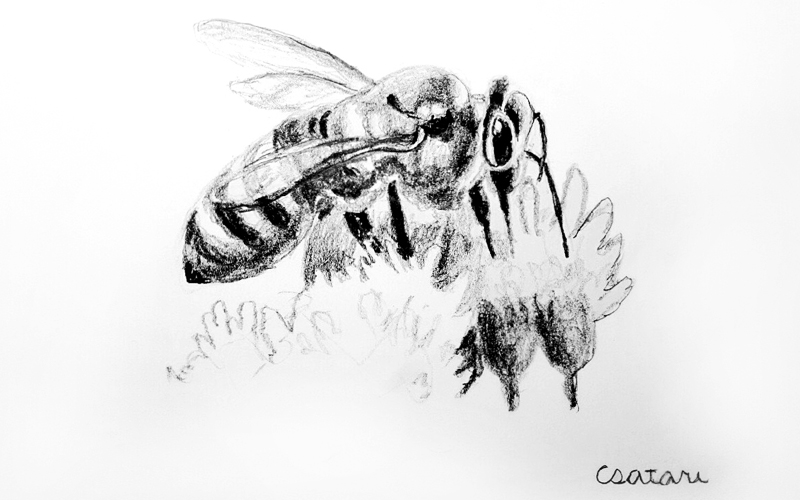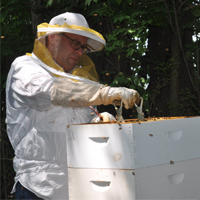On National Honey Bee Day, let’s give props to our pollinators and, maybe, learn how to be better humans.

by guest blogger Jeff Csatari, executive editor of Men’s Health and Women’s Health books
Once upon a time…I was a bee.
During the summer before my senior year of high school, I pollinated apricot trees for a research study at Rutgers University.
I worked a little differently from the way a worker bee works. Using a small vial of orange experimental pollen that looked like Kool-Aid, I dusted my right index finger and, from a ladder in apricot tree #32a, set about touching the pistils of every flower I could reach.
Not a bad summer job for an 18-year-old: fertilizing the female organs of hundreds of apricot flowers in a sunny orchard, listening to Grateful Dead tapes via speakers set on top of my lime-green Chevy Nova.
Sugar Magnolia, blossom’s bloomin’…head’s all empty and I don’t care.
Saw my baby down by the river, knew she had to come up soon for air.
Now, many years after that summer of love, I got hives.
I’m a first-year beekeeper. My teenagers call me The Beek—as in Bee Geek. And I have to agree, it’s impossible to look cool in a white full-length bee suit and veil.
But I don’t care. I started this hobby to help honeybees. You’ve heard about colony collapse disorder? Since 2009, beekeepers have been puzzled by the wide-scale deaths of hives that occur in winter. Worker bees abandon the hive, leaving the queen and honey stores. It’s a worrisome mystery. Honeybees, I’ve learned, are responsible for every third bite of food we take. No honeybees? No blueberries, no cauliflower, no apples or melons, no pumpkins or grapes. No wine. The list goes on.
I felt compelled to try to help out in a small way. So I took a beekeeping class at a junior college along with about 100 other folks from all walks of life who were similarly motivated.
I felt giddy with anticipation (and a little fear) driving home on April 10th with a box of 5,000 buzzing Italian honeybees (and one queen) in my backseat—sort of like a dad carefully driving his first newborn home from the hospital. What I didn’t realize at the time was how much trying to help bees would end up helping me.
Show Me the Honey
The honeybees are living at the corner of an organic farm field across the street from my home in a pinewood hive I built from a kit. The swarm took to the hive quickly, drawing out wax comb on the frames of the boxes, and the queen began filling the cells with eggs. I’ve read that a good queen can lay about 1,500 eggs per day. I must have been blessed with a good queen. It’s the end of August and I estimate there are close to 70,000 bees in the colony. The hive is now four boxes high, the top two heavy with honey.
I won’t harvest this first year—the bees need 60 to 80 pounds of honey for food to survive the winter. (That’s the big goal—avoid colony collapse and get ’em into next spring.) But that’s fine with me. The bees have given me much more than I’ll ever take.
Like any hobby—gardening, woodworking, running, fly-fishing—beekeeping is a welcome distraction from the drone of modern life. It’s impossible to focus on the stresses of work, managing a home, and worrying about college applications and aging parents when your head is inside a hive of 70,000 ornery stingers that think you’re a black bear trying to steal their golden treasure.
It Must Have Been the Roses
In the early mornings or evenings, I enjoy walking down the dirt road, past the organic farm field, the wildflowers, and sweet clover to the apiary at the edge of the woods. I’ll check on the bees’ progress and feed them sugar water mixed with a shot of Honey B Healthy vitamins. Sometimes, I’ll just sit on a stump nearby and watch the foragers fly in and out of the hive. “It’s like Newark airport,” one of my visitors observed recently.
Some workers fly straight out rising high above the trees. Others curve left around the honeysuckles toward the field of clover or maybe to the large ring of lavender about half mile to the east. Honeybees can travel 3 to 5 miles in search of nectar. When they find the bounty, they don’t selfishly keep it a secret. Rather, they hustle back home to tell their sisters, communicating the directions through an enthusiastic waggle dance. I’m amazed that they can navigate back to a 24-inch hive entrance from a distance of 5 miles, while I still get lost using a GPS.
A worker, which is a female bee, lives only 4 to 6 weeks in the summer, so those foragers I’m watching will never taste the honey they are storing for winter. They will be long dead. They are doing this work for their yet-to-emerge sisters and brothers—for the health of the colony. I’m in awe of their dedication to task and the community. A honeybee hive is pure buzzing socialism.
I’ve witnessed the bees defend the colony against intruders, such as hive beetles, robber bees from other hives, yellow jacket wasps, and me. When a bee stings, it’s a suicide act because it dies immediately after delivering its weapon into the flesh of its foe, the barbed stinger literally yanking its entrails out of its body as the bee flies away.
Man, bees have a tough life. Bears destroy their hives; skunks love to eat them; parasites like the varroa destructor and tracheal mites suck their blood. And we humans are making it even tougher on them. Scientists don’t know exactly what’s causing the winter colony collapse. Supposed culprits include lack of habitat and availability of diverse sources of pollen and nectar, global warming, viruses, parasites, genetically modified crops, pesticides containing neonicotinoids, even the practice of trucking beehives to farmers’ fields and orchards. Who knows the cause? Many experts believe it’s a combo deal: the result of a cocktail of insults small and large. The good news is that bees are, in many ways, smarter than us humans. (They’ve been around for 40 million years!) And each spring they reproduce rapidly. Still, the bees could use our help, and there are some simple things you can do that, even if they don’t impact collapse disorder, make sense for the pollinators and their planet.
Buzz Worthy
August 22 is National Honey Bee Day, a great opportunity to learn more about these social insects. Visit a local apiary, buy organic fruits and vegetables for your garden, plant large areas of native plants to create more diverse habitat, and teach a kid that insects like bees are not to be feared but are essential for a healthy Earth. To find Honey Bee Day activities, check with your local beekeepers association. Who knows, if you become intrigued (and I know you will), you might consider becoming a backyard beekeeper. Spread the honey!
Eastern Pennsylvania note: If you happen to live nearby Rodale Inc’s home office, there will be a day of free bee activity, including an observation hive, at the Pool Wildlife Sanctuary in Emmaus, Pennsylvania. The event is sponsored by the Lehigh Valley Beekeepers Association.
 Jeff Csatari is executive editor of Men’s Health and Women’s Health books.
Jeff Csatari is executive editor of Men’s Health and Women’s Health books.
Jeff’s father, illustrator Joseph Csatari, drew the honeybee sketch. You can see more of his artwork at csatari.com.




wonderful tale and definitely inspiring!
Wonderful piece! I grew up with a beekeeper about 2 blocks away from my home and was so fascinated by what he did that I did a junior high science fair project on it.